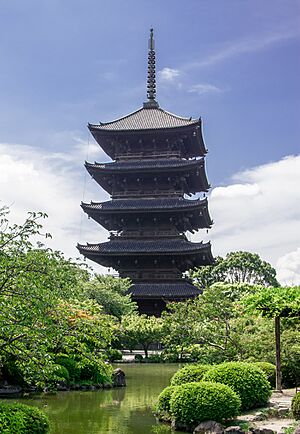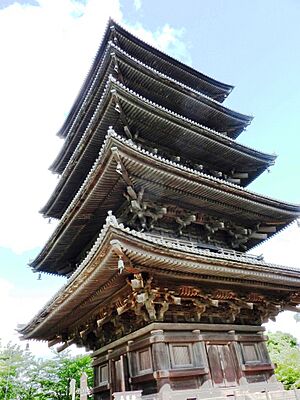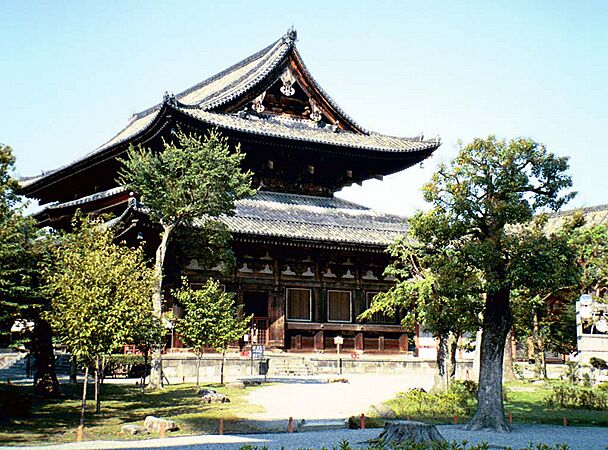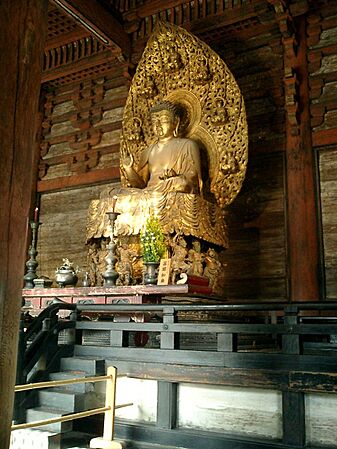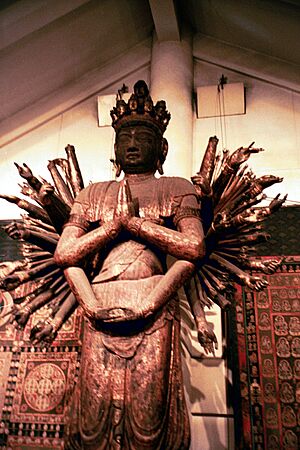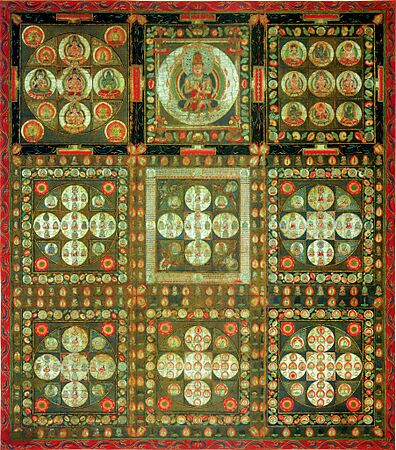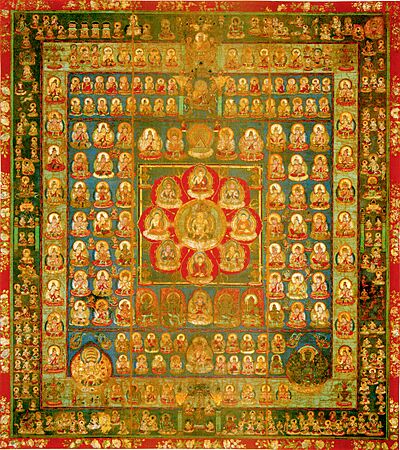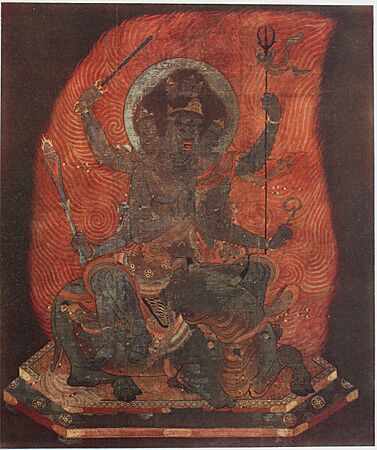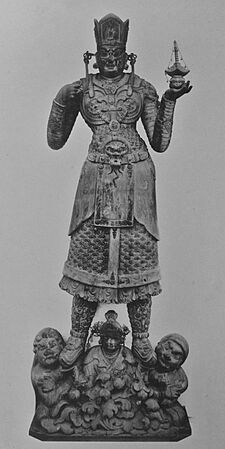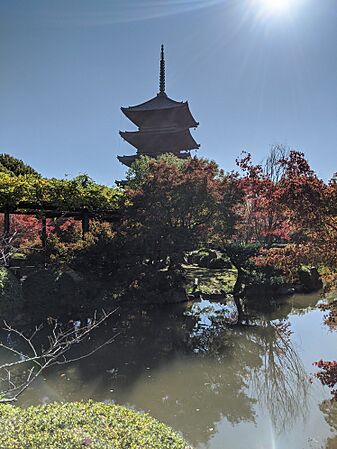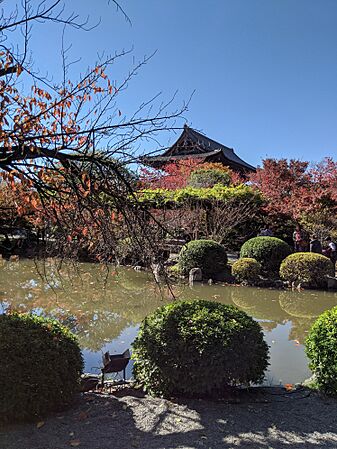Tō-ji facts for kids
Quick facts for kids Tō-ji東寺 |
|
|---|---|
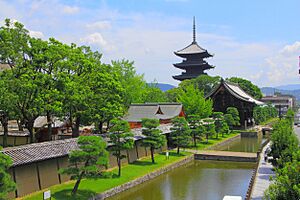
View of the Tō-ji complex
|
|
| Religion | |
| Affiliation | Tōji-Shingon |
| Deity | Yakushi Nyorai (Bhaiṣajyaguru) |
| Location | |
| Location | 1 Kujōchō, Minami-ku, Kyoto, Kyoto Prefecture |
| Country | Japan |
| Architecture | |
| Founder | Emperor Kanmu |
| Date established | 796 |
| Completed | 1644 (Reconstruction) |
| Website | |
| http://www.toji.or.jp/ | |
Tō-ji Temple (東寺, meaning "East Temple") is a famous Shingon Buddhist temple. It is located in the Minami-ku area of Kyoto, Japan. It is also known by a longer name, Kyō-ō-gokoku-ji (教王護国寺), which means The Temple for the Defense of the Nation by Means of the King of Doctrines.
Tō-ji was built in 796. At that time, it was one of only three Buddhist temples allowed in Kyoto. Kyoto was the capital of Japan back then. Because of its long history, Tō-ji holds many important treasures and documents. These items date back to the early Heian period and the Tang dynasty. The buildings on its grounds were built or rebuilt during different periods of Japanese history. These include the Kamakura period, Muromachi period, Momoyama period, and Edo period.
Five of Tō-ji's buildings are considered National Treasures. These are very important historical buildings. They include the Lotus Flower Gate (rengemon), the Miei Hall (mieidō), the Golden Hall (kondō), and the five-storied Pagoda (gojūnotō). The Kanchiin Guest Hall (kanchiin kyakuden) is also a National Treasure.
In 1994, Tō-ji was named a UNESCO World Heritage Site. It is part of the group called "Historic Monuments of Ancient Kyoto."
Contents
History of Tō-ji Temple
Tō-ji Temple was founded in the early Heian period. This was in the year 796. This was just two years after the capital city moved to Heian-kyō (which is now Kyoto). Tō-ji was one of only three Buddhist temples allowed in the capital city at that time. It is the only one of those three temples that still stands today.
Tō-ji once had a partner temple called Sai-ji (West Temple). Both temples stood near the Rashomon, which was the main gate to the Heian capital. Tō-ji was once known as The Temple for the Defense of the Nation. This shows that it was important for protecting the country. Tō-ji is located in Minami-ku, southwest of Kyōto Station.
Tō-ji is closely connected to a famous Buddhist priest named Kōbō Daishi (Kūkai). Even though Tō-ji became less important at the end of the Heian period, it became popular again later. This happened when people started to worship Kōbō Daishi more during the Kamakura period. Emperor Saga put Kōbō Daishi in charge of Tō-ji in 823. The main statue in the temple is of Yakushi Nyorai, also known as the Medicine Buddha. Many religious ceremonies for Kōbō Daishi are held in the Miei-dō (御影堂). This hall is also called Daishi-dō (大師堂) and was Kōbō Daishi's home. In 1586, a big earthquake caused serious damage to the temple.
Exploring Tō-ji's Architecture
The Five-story Pagoda
The five-storied Pagoda (五重塔, gojūnotō) at Tō-ji is a very famous building. The one you see today was rebuilt in 1643 during the Edo period. It was rebuilt by order of the third Tokugawa Shōgun, Iemitsu. The first pagoda was built in the 800s. However, it was destroyed and rebuilt four times before the current one. This pagoda was named a National Treasure in 1952.
The pagoda stands 54.8 meters (about 180 feet) tall. It is the tallest wooden tower in all of Japan. You can usually only go inside the pagoda on special days. But you can often see its beautiful interior from the outside. Inside, it holds important relics, sculptures, and paintings. On the ground floor, there are statues of four Buddhas. Each one faces a different direction.
Kondo: The Golden Hall
The Kondo, or Golden Hall, is the main building of the temple. Inside, you will find a large statue of Yakushi. This statue dates back to 1603.
Miedo: Kobo Daishi's Hall
The Miedo is a special hall dedicated to Kobo Daishi. He is also known as Kukai and was the founder of the temple. This hall stands where his original home used to be. The Miedo is opened on the 21st day of each month. On this day, a special service is held to honor Kukai.
Temple Grounds and Garden
The temple grounds are beautiful. They have a lovely garden and a pond. In the pond, you can see turtles and colorful koi fish swimming around. The grounds also have a private school called Rakunan. Many students from this school go on to study at top universities.
Tō-ji Flea Market
On the 21st day of every month, a very popular flea market takes place at Tō-ji. People often call this market "Kōbō-san." This name honors Kōbō Daishi (Kūkai), who passed away on the 21st day of the third month in 835 AD.
The flea market sells many different things. You can find antiques, art, clothes, and pottery. There is also some food and other typical second-hand market items. The biggest market of the year is held on December 21st.
There is a similar market on the 25th of every month at Kitano Tenmangū. This market is called Tenjin. There's a saying in Kyoto: "Fair weather at Tō-ji market means rainy weather at Tenjin market." This saying talks about Kyoto's changing weather.
A smaller market is also held at Tō-ji on the first Sunday of each month. This market is usually less crowded and focuses more on antiques.
The Story of Sai-ji
The Rashomon was once located to the west of Tō-ji. Today, only a marker shows where it used to be. You can reach it by walking a short distance west along Kujō Street. A little further west was Sai-ji (West Temple). Now, only a small park remains where Sai-ji once stood.
Tō-ji and Sai-ji were built at the southern edge of the capital city. They were the only Buddhist temples officially allowed in Heian-kyō at that time. Sai-ji disappeared in the the 1500s. This happened because the area had poor water systems and the temple did not have enough money to keep going.
There is a legend about a great drought. Kūkai, the priest at Tō-ji, and Shubin, a priest at Sai-ji, both prayed for rain. Kūkai succeeded, but Shubin did not. Shubin became jealous and shot an arrow at Kūkai. At that moment, a Jizō (a type of Buddhist statue) appeared. The Jizō took the arrow instead of Kūkai, saving his life. This Jizō statue is near the ruins of Rashōmon. It has a chip where the arrow is believed to have hit it.
Events at Tō-ji
Tō-ji Temple has been a special place for modern events too. In 1995, the temple was a stage for the Yanni World Tour, a famous music event.
On July 7, 2007, Tō-ji hosted one of the Live Earth concerts. These concerts were held around the world to help people learn about Earth's climate. Artists like Bonnie Pink, Michael Nyman, Rip Slyme, UA, and the Yellow Magic Orchestra performed there.
Gallery
See also
- List of Buddhist temples in Kyoto
- List of National Treasures of Japan (residences)
- List of National Treasures of Japan (temples)
- List of National Treasures of Japan (ancient documents)
- List of National Treasures of Japan (paintings)
- List of National Treasures of Japan (sculptures)
- List of National Treasures of Japan (writings)
- List of National Treasures of Japan (crafts-others)
- List of tallest structures built before the 20th century
- Thirteen Buddhist Sites of Kyoto
- For an explanation of terms concerning Japanese Buddhism, Japanese Buddhist art, and Japanese Buddhist temple architecture, see the Glossary of Japanese Buddhism.


